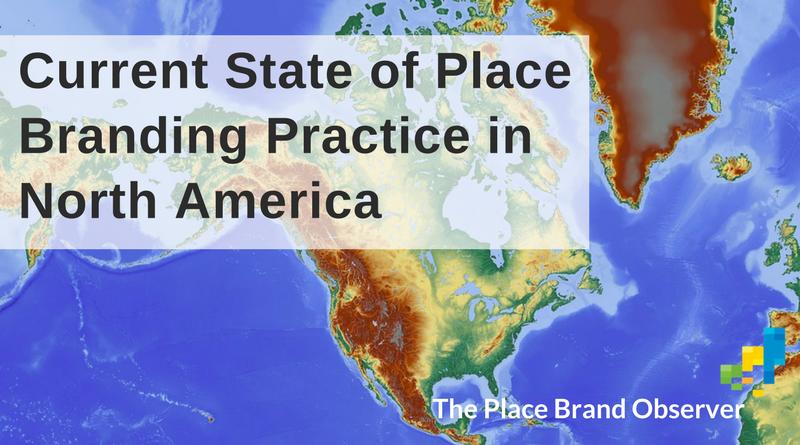What is the current state of place branding practice in North America? In this post, learn what leading place brand developers, managers and advisors think about the branding of cities, countries and destinations in North America.
Learn about:
- How North America compares to other regions with regard to place branding practice;
- Which cities, regions or destinations in North America are leading in place branding practice;
- The challenges North American cities, regions or destinations face in their place brand development, management and marketing;
- Books on place branding by and for North Americans.
Views on place branding practice in North America
As President of Resonance consultancy, Chris Fair knows the North American market very well, and has been involved in many place branding initiatives. Asked about his thoughts on the current state of place branding practice in North America, here’s what he offered:
“In my view, we are 10-15 years behind Europe in terms of the understanding and development of place branding theory and practices in North America. Which is somewhat ironic considering the strength and expertise of branding as a practice in the United States in general.”
So how does he explain the slow uptake of strategic place branding in North America? His answer:
“I believe this has a lot to do with the number of countries in Europe versus North America and obviously the history of regions within each of those countries who have competed with one another for longer than the U.S. or Canada has even existed.”
We asked the same question to Frank Cutitta, Editor at Large of the Smart & Resilient Cities web portal. He told us this:
“I would say that many ad agencies, research firms and academic institutions see place branding as a subset of their tourism and economic development portfolios. This is perfectly fine, but in my work there are dozens of subtleties related to the smart city evolution that don’t fall directly under the traditional place branding strategy.”
No clear understanding of what place branding means and how it differs from place marketing (we wrote a quick guide on this topic, available here) seems to be a key issue affecting many place professionals in North America. Following Frank Cutitta’s lead, here’s one way to know whether you are involved in place marketing or place branding. Ask yourself:
How much of your place branding strategy is directed internally, to the citizens and current business constituents of your city, region or destination, versus how much is spent focusing on attracting new business and inhabitants?
Why is this inward-focus so important for place branding success? Cutitta explains:
“Our experience tells us that strategic place or neighborhood-specific communications programs targeted to the current residents are foundational to external place branding strategies.”
How does North America compare to other regions?
Chris Fair already indicated that North America has ground to catch up in embracing place branding as strategy to develop a sustainable competitive identity and reputation for cities, regions or countries. Europe seems the undisputed leader in the field, also with regard to academic interest. As David Gertner, Marketing Professor at Pace University’s Lubin School of Business told us:
“My general impression is that place branding/marketing has received more attention from European scholars. However, the differences, if any, between the research in place branding developed in the United States and in other countries might be better explained by size of countries, competitive environment, stage of economic development, dependence on tourism, etc. My impression is that most articles in the field address places with image problems and are developed by people who have some connection with these locales.”
What about destination branding?
Moving from place branding (an umbrella term referring to the branding of all sorts of places, from shopping mall to city, region and country) to the tourism-specific destination branding, we reached out to Michael Gehrisch of Destination Marketing Association International (DMAI) whether he thought destination branding plays a role in North America. His answer: Absolutely. Like most of the place professionals who form part of our interview series, Gehrisch observes growing competition among cities, regions and countries for visitors, talent and investment, globally and at home, in the U.S. As he puts it:
“This is no different in the U.S. In fact it’s the reason that President Barack Obama created a national tourism and travel strategy and began funding for Brand USA. The name of the U.S. national tourism board is no coincidence. President Obama understood the importance of promoting the national brand around the world. For cities and states within the United States, the story is not different.”
Place branding examples
Apart from Brand USA and well known examples such as New York City, it’s often the second- or third tier cities, smaller destinations and communities which can expect the most benefit from smart place branding.
Looking through our collection of case studies, there are some intriguing examples of place branding in North America. For instance, David Ferreira, Jeannette Hanna and Malcolm Allan shared with us how the Canadian city of Mississauga developed a city brand strategy to attract and retain talent. Then there was the intriguing case study by Bill Baker on how to change the name of a destination (Lane County).
Housing developments are another area where place branding has become an indispensable part of the placemaking process. The case study by Studio Sanderson on how place branding was used for the development of Hudson Woods at the foot of the Catskills in New York, illustrates this point.
Much bolder the city branding attempt by Guadalajara in Mexico. Unfortunately, most place branding initiatives are prone to failure, and Guadalajara, Mexico’s second largest city, wasn’t immune to the 7 deadly problems of place branding projects, as Gunter Soydanbay reported.
Place branding books by and for North Americans
Below a few books which have been recommended by place branders in North America:
 Destination Branding for Small Cities
Destination Branding for Small Cities
Bill Baker (Second ed. 2012, Creative Leap Books)
In his second book, Bill Baker again skillfully cuts through the theory, advertising-speak and branding jargon to simplify and clarify the practice of branding small cities for improved tourism, economic development, placemaking and urban design.
This must-read primer shows how to uncover your most potent brand platform, and provides real world examples, as well as affordable, proven tools, templates and checklists to help breathe life into small city branding and marketing.
Get Destination Branding for Small Cities through Amazon.
 Brand America: The Mother of All Brands
Brand America: The Mother of All Brands
Simon Anholt, Jeremy Hildreth (2004, Cyan Communications)
Offering a different, but significant, perspective on how America shapes the world, this book describes the ways in which America has become the largest and most powerful brand in the global marketplace. The three most profitable business sectors—entertainment, merchant banking, and information technology—are discussed along with the positive branding attributes that America has in abundance, including sporting prowess, technological achievement, wealth, and definitive youth lifestyle.
Get Brand America through Amazon.
 Marketing Places
Marketing Places
Philip Kotler, Ronald Haider, Irving Rein (2002, Free Press)
In this first book on place marketing, Philip Kotler argues that thousands of “places” – cities, states, and nations – are in crisis, and can no longer rely on national industrial policies, such as federal matching funds, as a promise of jobs and protection.
The authors show that places must, like any market-driven business, become attractive “products” by improving their industrial base and communicating their special qualities more effectively to their target markets. From studies of cities and nations throughout the world, Kotler offer a systematic analysis of why so many places have fallen on hard times, and make recommendations on what can be done to revitalize a place’s economy.
Get Marketing Places through Amazon.
That’s all we have at the moment on place branding in North America. If you’d like to explore further, why not zoom in on our world map for in-depth interviews with leading place managers, marketers and developers in North America.
Over to you:
What do you think about the current state of place branding practice in North America? Do you agree with the views shared in this post regarding the current state of place branding practice in North America? Comments welcome.



I agree with the comments by Chris Fair and Frank Cutitta. While progress is being made, particularly in Tier 1 and 2 cities, there remains a fixation by many others on logos, taglines and themes for advertising. Our challenge worldwide remains a lack of awareness and understanding of what place branding represents and the benefits it can deliver. While many thought leaders within communities may be gaining a better understanding, things can lapse when Boards, committees and other leadership groups are not always on-board. Place brand education will remain a critical challenge for the foreseeable future.
Thanks, Bill. We are hopeful that over time we’ll be able to reach a critical mass of place leaders and help them understand and appreciate the opportunities presented by place branding if approached strategically and not just as promotional campaign.